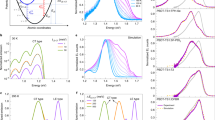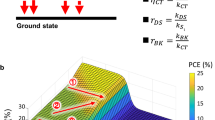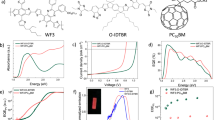Abstract
The open-circuit voltage of organic solar cells is usually lower than the values achieved in inorganic or perovskite photovoltaic devices with comparable bandgaps. Energy losses during charge separation at the donor–acceptor interface and non-radiative recombination are among the main causes of such voltage losses. Here we combine spectroscopic and quantum-chemistry approaches to identify key rules for minimizing voltage losses: (1) a low energy offset between donor and acceptor molecular states and (2) high photoluminescence yield of the low-gap material in the blend. Following these rules, we present a range of existing and new donor–acceptor systems that combine efficient photocurrent generation with electroluminescence yield up to 0.03%, leading to non-radiative voltage losses as small as 0.21 V. This study provides a rationale to explain and further improve the performance of recently demonstrated high-open-circuit-voltage organic solar cells.
This is a preview of subscription content, access via your institution
Access options
Access Nature and 54 other Nature Portfolio journals
Get Nature+, our best-value online-access subscription
$29.99 / 30 days
cancel any time
Subscribe to this journal
Receive 12 print issues and online access
$259.00 per year
only $21.58 per issue
Buy this article
- Purchase on Springer Link
- Instant access to full article PDF
Prices may be subject to local taxes which are calculated during checkout




Similar content being viewed by others
References
Yu, G., Gao, J., Hummelen, J. C., Wudl, F. & Heeger, A. J. Polymer photovoltaic cells: enhanced efficiencies via a network of internal donor–acceptor heterojunctions. Science 270, 1789–1791 (1995).
Gelinas, S. et al. Ultrafast long-range charge separation in organic semiconductor photovoltaic diodes. Science 343, 512–516 (2014).
Park, S. H. et al. Bulk heterojunction solar cells with internal quantum efficiency approaching 100%. Nat. Photon. 3, 297–302 (2009).
He, Z. et al. Single-junction polymer solar cells with high efficiency and photovoltage. Nat. Photon. 9, 174–179 (2015).
Vandewal, K. et al. Quantification of quantum efficiency and energy losses in low bandgap polymer:fullerene solar cells with high open-circuit voltage. Adv. Funct. Mater. 22, 3480–3490 (2012).
Yao, J. et al. Quantifying losses in open-circuit voltage in solution-processable solar cells. Phys. Rev. Appl. 4, 014020 (2015).
Green, M. A. Radiative efficiency of state-of-the-art photovoltaic cells. Prog. Photovolt. 20, 472–476 (2012).
Vandewal, K., Tvingstedt, K., Gadisa, A., Inganäs, O. & Manca, J. V. Relating the open-circuit voltage to interface molecular properties of donor:acceptor bulk heterojunction solar cells. Phys. Rev. B 81, 125204 (2010).
Burke, T. M., Sweetnam, S., Vandewal, K. & McGehee, M. D. Beyond Langevin recombination: how equilibrium between free carriers and charge transfer states determines the open-circuit voltage of organic solar cells. Adv. Energy Mater. 5, 1500123 (2015).
Chen, X.-K., Ravva, M. K., Li, H., Ryno, S. M. & Brédas, J.-L. Effect of molecular packing and charge delocalization on the nonradiative recombination of charge-transfer states in organic solar cells. Adv. Energy Mater. 6, 1601325 (2016).
McGlynn, S. P. Energetics of molecular complexes. Chem. Rev. 58, 1113–1156 (1958).
Li, W., Hendriks, K. H., Furlan, A., Wienk, M. M. & Janssen, R. A. J. High quantum efficiencies in polymer solar cells at energy losses below 0.6 eV. J. Am. Chem. Soc. 137, 2231–2234 (2015).
Menke, S. M. et al. Limits for recombination in a low energy loss organic heterojunction. ACS Nano 10, 10736–10744 (2016).
Kawashima, K., Tamai, Y., Ohkita, H., Osaka, I. & Takimiya, K. High-efficiency polymer solar cells with small photon energy loss. Nat. Commun. 6, 10085 (2015).
Liu, J. et al. Fast charge separation in a non-fullerene organic solar cell with a small driving force. Nat. Energy 1, 16089 (2016).
Baran, D. et al. Reduced voltage losses yield 10% efficient fullerene free organic solar cells with >1 V open circuit voltages. Energy Environ. Sci. 9, 3783–3793 (2016).
Hou, J. H., Inganas, O., Friend, R. H. & Gao, F. Organic solar cells based on non-fullerene acceptors. Nat. Mater. 17, 119–128 (2018).
Rau, U. Reciprocity relation between photovoltaic quantum efficiency and electroluminescent emission of solar cells. Phys. Rev. B 76, 085303 (2007).
Kirchartz, T., Taretto, K. & Rau, U. Efficiency limits of organic bulk heterojunction solar cells. J. Phys. Chem. C 113, 17958–17966 (2009).
Benduhn, J. et al. Intrinsic non-radiative voltage losses in fullerene-based organic solar cells. Nat. Energy 2, 17053 (2017).
Miller, O. D., Yablonovitch, E. & Kurtz, S. R. Strong internal and external luminescence as solar cells approach the Shockley-Queisser limit. IEEE J. Photovolt. 2, 303–311 (2012).
Zhang, H. et al. Fullerene-free polymer solar cell based on a polythiophene derivative with an unprecedented energy loss of less than 0.5 eV. J. Mater. Chem. A 4, 18043–18049 (2016).
Kawashima, K., Osaka, I. & Takimiya, K. Effect of chalcogen atom on the properties of naphthobischalcogenadiazole-based π-conjugated polymers. Chem. Mater. 27, 6558–6570 (2015).
Liao, S. H., Jhuo, H. J., Cheng, Y. S. & Chen, S. A. Fullerene derivative-doped zinc oxide nanofilm as the cathode of inverted polymer solar cells with low-bandgap polymer (PTB7-Th) for high performance. Adv. Mater. 25, 4766–4771 (2013).
Duan, R. et al. Application of two-dimensional conjugated benzo[1,2-b:4,5-b′]dithiophene in quinoxaline-based photovoltaic polymers. Macromolecules 45, 3032–3038 (2012).
Chen, S. et al. A wide-bandgap donor polymer for highly efficient non-fullerene organic solar cells with a small voltage Lloss. J. Am. Chem. Soc. 139, 6298–6301 (2017).
Lin, Y. et al. An electron acceptor challenging fullerenes for efficient polymer solar cells. Adv. Mater. 27, 1170–1174 (2015).
Holliday, S. et al. High-efficiency and air-stable P3HT-based polymer solar cells with a new non-fullerene acceptor. Nat. Commun. 7, 11585 (2016).
Baran, D. et al. Reducing the efficiency–stability–cost gap of organic photovoltaics with highly efficient and stable small molecule acceptor ternary solar cells. Nat. Mater. 16, 363–369 (2017).
Zhao, W. et al. Molecular optimization enables over 13% efficiency in organic solar cells. J. Am. Chem. Soc. 139, 7148–7151 (2017).
Dai, S. et al. Fused nonacyclic electron acceptors for efficient polymer solar cells. J. Am. Chem. Soc. 139, 1336–1343 (2017).
Perez, M. D., Borek, C., Forrest, S. R. & Thompson, M. E. Molecular and morphological influences on the open circuit voltages of organic photovoltaic devices. J. Am. Chem. Soc. 131, 9281–9286 (2009).
Potscavage, W. J., Sharma, A. & Kippelen, B. Critical interfaces in organic solar cells and their influence on the open-circuit voltage. Acc. Chem. Res. 42, 1758–1767 (2009).
Goris, L. et al. Observation of the subgap optical absorption in polymer–fullerene blend solar cells. Appl. Phys. Lett. 88, 052113 (2006).
Tvingstedt, K. et al. Electroluminescence from charge transfer states in polymer solar cells. J. Am. Chem. Soc. 131, 11819–11824 (2009).
Vandewal, K., Tvingstedt, K., Gadisa, A., Inganäs, O., & Manca, J. V. On the origin of the open-circuit voltage of polymer–fullerene solar cells. Nat. Mater. 8, 904–909 (2009).
Dimitrov, S. D. & Durrant, J. R. Materials design considerations for charge generation in organic solar cells. Chem. Mater. 26, 616–630 (2014).
Abbaszadeh, D. et al. Elimination of charge carrier trapping in diluted semiconductors. Nat. Mater. 15, 628–633 (2016).
Wall, M. E., Rechtsteiner, A. & Rocha, L. M. in A Practical Approach to Microarray Data Analysis (eds Berrar, D. P., Dubitzky, W. & Granzow, M.) 91–109 (Kluwer, Norwell, MA, 2003).
Stoltzfus, D. M. et al. Charge generation pathways in organic solar cells: assessing the contribution from the electron acceptor. Chem. Rev. 116, 12920–12955 (2016).
Bässler, H. & Köhler, A. ‘Hot or cold’: how do charge transfer states at the donor–acceptor interface of an organic solar cell dissociate? Phys. Chem. Chem. Phys. 17, 28451–28462 (2015).
Deibel, C. & Dyakonov, V. Polymer–fullerene bulk heterojunction solar cells. Rep. Prog. Phys. 73, 096401 (2010).
Grancini, G. et al. Hot exciton dissociation in polymer solar cells. Nat. Mater. 12, 29–33 (2013).
Jailaubekov, A. E. et al. Hot charge-transfer excitons set the time limit for charge separation at donor/acceptor interfaces in organic photovoltaics. Nat. Mater. 12, 66–73 (2013).
Savoie, B. M. et al. Unequal partnership: asymmetric roles of polymeric donor and fullerene acceptor in generating free charge. J. Am. Chem. Soc. 136, 2876–2884 (2014).
Weu, A. et al. Field-assisted exciton dissociation in highly efficient PffBT4T-2OD: fullerene organic solar cells. Chem. Mater. 30, 2660–2667 (2018).
Bixon, M., Jortner, J. & Verhoeven, J. W. Lifetimes for radiative charge recombination in donor–acceptor molecules. J. Am. Chem. Soc. 116, 7349–7355 (1994).
Vandewal, K., Tvingstedt, K. & Inganäs, O. Polarization anisotropy of charge transfer absorption and emission of aligned polymer: fullerene blend films. Phys. Rev. B 86, 035212 (2012).
Yao, H. et al. Design and synthesis of a low bandgap small molecule acceptor for efficient polymer solar cells. Adv. Mater. 28, 8283–8287 (2016).
Snaith, H. The perils of solar cell efficiency measurements. Nat. Photon. 6, 337–340 (2012).
Hirata, S. & Head-Gordon, M. Time-dependent density functional theory for radicals—an improved description of excited states with substantial double excitation character. Chem. Phys. Lett. 302, 375–382 (1999).
Grimme, S., Antony, J., Ehrlich, S. & Krieg, H. A consistent and accurate ab initio parametrization of density functional dispersion correction (DFT-D) for the 94 elements H-Pu. J. Chem. Phys. 132, 154104 (2010).
Stewart, J. J. P. Optimization of parameters for semiempirical methods VI: more modifications to the NDDO approximations and re-optimization of parameters. J. Mol. Model. 19, 1–32 (2013).
Barbara, P. F., Meyer, T. J. & Ratner, M. A. Contemporary issues in electron transfer research. J. Phys. Chem. 100, 13148–13168 (1996).
Cave, R. J. & Newton, M. D. Generalization of the Mulliken–Hush treatment for the calculation of electron transfer matrix elements. Chem. Phys. Lett. 249, 15–19 (1996).
Frisch, M. J. et al. GAUSSIAN09 (Gaussian, Inc., 2009).
Frisch, M. J. et al. Gaussian 16 Revision A. 03. 2016 (Gaussian, Inc., 2016).
Shao, Y. et al. Advances in methods and algorithms in a modern quantum chemistry program package. Phys. Chem. Chem. Phys. 8, 3172–3191 (2006).
Acknowledgements
The authors thank J. Durrant, J.-S. Kim, M. Pshenichnikov and D. Paraschuk for useful discussions. The research was supported by the Swedish Energy Agency Energimyndigheten (grant no. 2016-010174), the Swedish Research Council VR (grant nos 621-2013-5561, 2016-06146, and 2017-00744), the Swedish Government Strategic Research Area in Materials Science on Functional Materials at Linköping University (faculty grant no. SFO-Mat-LiU #2009-00971), the National Natural Science Foundation of China (grants nos 91633301, 51673201 and 21325419), the Chinese Academy of Sciences (grant no. XDB12030200), the China Scholarship Council (CSC) (no. 201306730002) and the Department of the Navy, Office of Naval Research, under the MURI ‘Center for Advanced Organic Photovoltaics’ (awards nos N00014-14-1-0580 and N00014-16-1-2520). F.G. is a Wallenberg Academy Fellow and O.I. is a Wallenberg Scholar. A.A.B. is a Royal Society University Research Fellow. This project has also received funding from the European Research Council (ERC) under the European Union’s Horizon 2020 research and innovation programme (grant agreement nos 639750 and 717026). W.T. acknowledges an Ambizione fellowship from the Swiss National Science Foundation.
Competing interests
The authors declare no competing interests.
Author information
Authors and Affiliations
Contributions
F.G. conceived and directed the project. D.Q. fabricated the solar cell devices, performed the FTPS, steady-state photoluminescence, electroluminescence and EQEEL experiments. Z.Z. carried out the DFT calculations. X.L. performed the PLQE measurements. S.C. and G.P. carried out the transient photoluminescence measurements. H.F.Y., J.L., S.S.C. and S.L. synthesized the materials. T.R.H. and A.A.B. carried out the transient absorption measurements. T.R.H., J.Z. and A.A.B. analysed the time-resolved data. B.G. and Y.J. fabricated the solar cell devices. L.O. performed the cyclic voltammetry measurements. D.Q. was supervised by F.G. and F.Z. J.B. and V.C. supervised the DFT calculations. J.H. and H.Y. supervised the materials synthesis and device fabrication. I.B. and W.C. supervised the transient photoluminescence measurements. W.T., O.I. and F.Z. participated in data interpretation. D.Q., W.T., T.R.H., V.C., A.A.B. and F.G. wrote the manuscript. All authors discussed the results and commented on the final manuscript.
Corresponding authors
Additional information
Publisher’s note: Springer Nature remains neutral with regard to jurisdictional claims in published maps and institutional affiliations.
Supplementary information
Supplementary Information
Supplementary Figures 1–18, Supplementary Tables 1–10, Supplementary References 1–8
Rights and permissions
About this article
Cite this article
Qian, D., Zheng, Z., Yao, H. et al. Design rules for minimizing voltage losses in high-efficiency organic solar cells. Nature Mater 17, 703–709 (2018). https://doi.org/10.1038/s41563-018-0128-z
Received:
Accepted:
Published:
Issue Date:
DOI: https://doi.org/10.1038/s41563-018-0128-z
This article is cited by
-
Physical insights into non-fullerene organic photovoltaics
Nature Reviews Physics (2024)
-
Rational molecular and device design enables organic solar cells approaching 20% efficiency
Nature Communications (2024)
-
The role of interfacial donor–acceptor percolation in efficient and stable all-polymer solar cells
Nature Communications (2024)
-
Decreasing exciton dissociation rates for reduced voltage losses in organic solar cells
Nature Communications (2024)
-
Tuning polymer-backbone coplanarity and conformational order to achieve high-performance printed all-polymer solar cells
Nature Communications (2024)



